
Though extremely plant-like in appearance, sponges are actually one of the most primitive animals in the sea. They belong to a group called porifera. Most of us are familiar with the dried colorless varieties that populate the kitchens and bathrooms of the world. But in the ocean, live sponges can be found in an infinite variety of colors and shapes. Most of them are relatively small, but some varieties can grow to over 6 feet in diameter. Sponges differ from all other marine invertebrates in that they have no true tissues or organs. Their structure is composed of simple aggregations of cells. The name porifera means pore bearer. The tissue of sponges encloses a vast network of chambers and canals that connect to the open pores on their surface. Sponges feed by drawing a current of water in through their pores, filtering out the nutrients, and then ejecting it out through an opening. Many sponges on the coral reef resemble some of the corals in shape and color, but upon closer inspection the difference is apparent. They are one of the many life forms unique to the ocean environment. Sea squirts are very similar to sponges in appearance. They belong to a group called chordata. They are usually found growing in clusters on rocks. Like sponges, they filter particles of food from the water by pumping it through tiny pores and then expelling it through a central opening. Below is a listing of some common coral reef sponges & sea squirts.
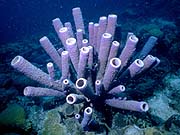
The tube sponge is one of the most common varieties of sponge to be found on the reef. It is distinguished by its long tube-shaped growths, and ranges in color from purple to blue, gray, and gray-green. Filtered water is ejected through the large openings on the ends. This is one of the few coral reef invertebrates that is blue in color.
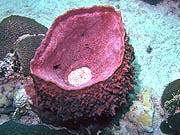
The vase sponge is a common species found in the Caribbean off the eastern coast of Florida. It is characterized by a large bell shape with a deep central cavity. This sponge grows up to 2 feet wide and 3 feet high. It ranges in color from purple to red and brown, and is found attached to rocks near the sandy bottoms.
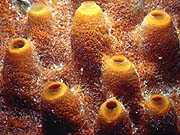
This small yellow sponge species is commonly found throughout the Pacific coastal waters of the United States. It is found growing in small colonies, and ranges in color from orange to bright yellow. This sponge and can be found encrusting rocks on the coral reef face.
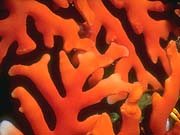
This bright red sponge species is very common throughout the Caribbean Sea. This sponge usually grows to a height of about 8 inches. This is one species that is easy to keep and can do relatively well in a home aquarium environment. These sponges require a moderate water flow and dim light to do well.
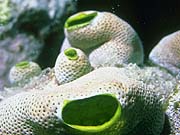
This species of sea squirt is very common on the coral reef, and is usually found in deep water. It can be found encrusting the rocks in large colonies. This squirt's leathery bag-like body has a white and gray or brown spotted exterior with a bright green interior. It is sometimes introduced into the aquarium on live rock.
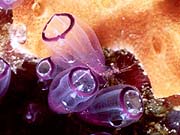
The tunicates are very similar to sea squirts. They take water in through a large opening where nutrients are filtered out. The water is then expelled through another opening. Painted tunicates are about 3/4 inch long and commonly grow in colonies. They are found in translucent red, purple, and yellow colors., and are very common on the coral reef.
Sponges & Sea Squirts | Corals & Anemones | Sea Worms | Echinoderms
Crustaceans | Mollusks | Coral Reef Fishes | Unusual Reef Fishes
Sharks & Rays | Marine Reptiles | Marine Mammals